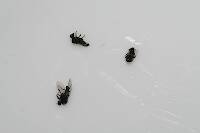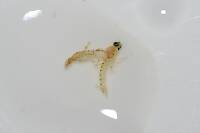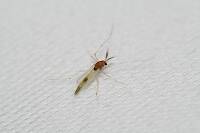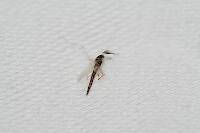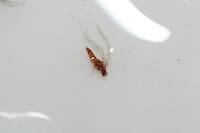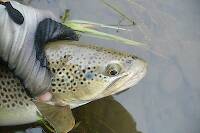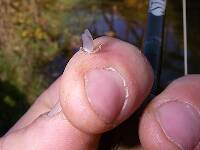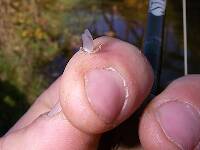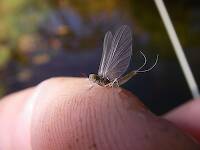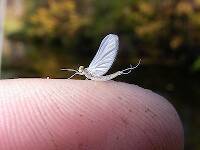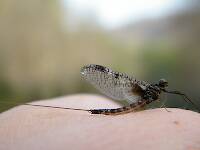
Salmonflies
Pteronarcys californica
The giant Salmonflies of the Western mountains are legendary for their proclivity to elicit consistent dry-fly action and ferocious strikes.
Featured on the forum

As far as I can tell, this species has only previously been reported from one site in Oregon along the Columbia gorge. However, the key characteristics are fairly unmistakable in all except for one minor detail:
— 4 small yellow spots on frons visible in photos
— Narrow occipital spinule row curves forward (but doesn’t quite meet on stem of ecdysial suture, as it's supposed to in this species)
— Short spinules on anterior margin of front legs
— Short rposterior row of blunt spinules on abdominal tergae, rather than elongated spinules dorsally
I caught several of these mature nymphs in the fishless, tiny headwaters of a creek high in the Wenatchee Mountains.
— 4 small yellow spots on frons visible in photos
— Narrow occipital spinule row curves forward (but doesn’t quite meet on stem of ecdysial suture, as it's supposed to in this species)
— Short spinules on anterior margin of front legs
— Short rposterior row of blunt spinules on abdominal tergae, rather than elongated spinules dorsally
I caught several of these mature nymphs in the fishless, tiny headwaters of a creek high in the Wenatchee Mountains.

Troutnut is a project started in 2003 by salmonid ecologist Jason "Troutnut" Neuswanger to help anglers and
fly tyers unabashedly embrace the entomological side of the sport. Learn more about Troutnut or
support the project for an enhanced experience here.
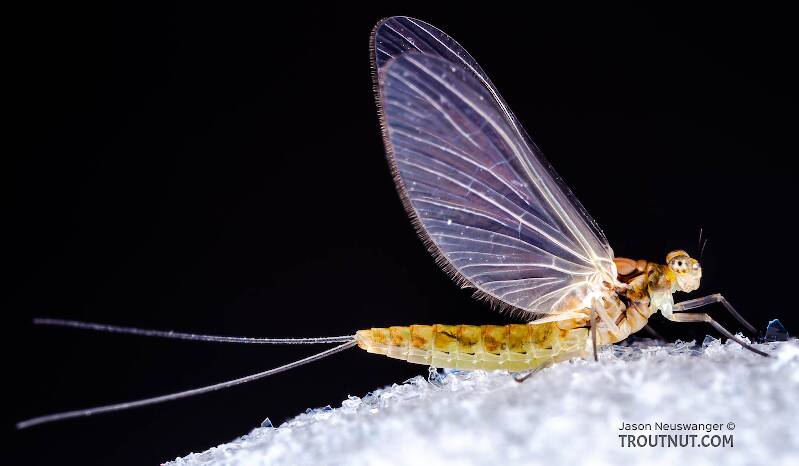
This dun of a fairly large Baetidae species was one of only a couple I saw all evening.
Taxon on Aug 27, 2006August 27th, 2006, 5:55 pm EDT
Jason-
My belief is that Plauditus, Pseudocloeon, and Procloeon are the Baetids absent hind wings, whereas Centroptilum (among the others) has minute hind wings. If I am correct, then given the choice you posed, that would make your specimen Centroptilum. This is (of course) strictly based on my having successfully digested the "available literature", and as I remember, there was a bit of inconsistency between authors in that area, so I probably chose to believe whichever one (or ones) I believed to have more credibility. Does any of this sound familiar?
My belief is that Plauditus, Pseudocloeon, and Procloeon are the Baetids absent hind wings, whereas Centroptilum (among the others) has minute hind wings. If I am correct, then given the choice you posed, that would make your specimen Centroptilum. This is (of course) strictly based on my having successfully digested the "available literature", and as I remember, there was a bit of inconsistency between authors in that area, so I probably chose to believe whichever one (or ones) I believed to have more credibility. Does any of this sound familiar?
Troutnut on Aug 27, 2006August 27th, 2006, 6:20 pm EDT
If I'm reading the key in Merritt & Cummins correctly, Procloeon can have hind wings present or absent. I think the angling literature is based on older sources, and the species were shuffled around a lot since the publication of most of those books.
I tried to find a paper on Procloeon identification on the FAMU site without any luck. I guess I'll have to spend some time in the Cornell library this winter for this one.
I tried to find a paper on Procloeon identification on the FAMU site without any luck. I guess I'll have to spend some time in the Cornell library this winter for this one.
Jason Neuswanger, Ph.D.
Troutnut and salmonid ecologist
Troutnut and salmonid ecologist
Entoman on Jul 13, 2011July 13th, 2011, 1:39 pm EDT
Jason & Roger-
Boy, this is another example of the value of your updates to the site Jason. Related Topics pulled this topic up and even though it is almost 5 years old, it has important relevance to the current discussions we're having about the genus Centroptilum.
Though the difficulties in place 5 years ago are still in play for the baetids, luckily the presence of single intercalaries and hind wings reduces the possibilities to two genera, Centroptillum and Procloeon.
Besides the shuffling of species among genera, to call morphological information on their females scant is an understatement. Looking at the males, there is one species I'm aware of sized this large and with hind wings this severly slender (described as more than 6 times long as wide) that also has the spurs (curving spikes) and a NY distribution. It is also one of those that "stayed home" in Centroptilum. In the old nomenclature it was referred to as C. convexum. It is now considered synonymous with C. album, which is where I'd place this specimen. Hopefully somebody will be able to supply better information now or in the future, but this is such a beautiful example of the look, I'll move it there if you concur.
Regards,
Kurt
Boy, this is another example of the value of your updates to the site Jason. Related Topics pulled this topic up and even though it is almost 5 years old, it has important relevance to the current discussions we're having about the genus Centroptilum.
Though the difficulties in place 5 years ago are still in play for the baetids, luckily the presence of single intercalaries and hind wings reduces the possibilities to two genera, Centroptillum and Procloeon.
Besides the shuffling of species among genera, to call morphological information on their females scant is an understatement. Looking at the males, there is one species I'm aware of sized this large and with hind wings this severly slender (described as more than 6 times long as wide) that also has the spurs (curving spikes) and a NY distribution. It is also one of those that "stayed home" in Centroptilum. In the old nomenclature it was referred to as C. convexum. It is now considered synonymous with C. album, which is where I'd place this specimen. Hopefully somebody will be able to supply better information now or in the future, but this is such a beautiful example of the look, I'll move it there if you concur.
Regards,
Kurt
"It's not that I find fishing so important, it's just that I find all other endeavors of Man equally unimportant... And not nearly as much fun!" Robert Traver, Anatomy of a Fisherman
Entoman on Jul 13, 2011July 13th, 2011, 2:56 pm EDT
Follow up-
I forgot to adequately address the elephant in the room, which is the size of this critter. 7mm is definitely outsized for most species of Centroptillum and all the species of Procloeon that I'm aware of. Your specimen's size is probably a better indicator for album than hind wing conformation since it's female. There is another synonym of C. album, the prev. C. walshi that has been documented to attain this size and even larger.
I forgot to adequately address the elephant in the room, which is the size of this critter. 7mm is definitely outsized for most species of Centroptillum and all the species of Procloeon that I'm aware of. Your specimen's size is probably a better indicator for album than hind wing conformation since it's female. There is another synonym of C. album, the prev. C. walshi that has been documented to attain this size and even larger.
"It's not that I find fishing so important, it's just that I find all other endeavors of Man equally unimportant... And not nearly as much fun!" Robert Traver, Anatomy of a Fisherman
Oldredbarn on Jul 14, 2011July 14th, 2011, 9:37 am EDT
I don't want to in any way distract from your discussion on the placement of this one, but what a gorgeous bug! The photography is wonderful, but I wonder a bit on the lighting and its effect on its "true" color. But you can't beat the available detail etc.
In the photo of its underside what's going on there in the area of the thorax? It appears to be bubbles you can see inside it. Thats not eggs that far up is it?
Spence
In the photo of its underside what's going on there in the area of the thorax? It appears to be bubbles you can see inside it. Thats not eggs that far up is it?
Spence
"Even when my best efforts fail it's a satisfying challenge, and that, after all, is the essence of fly fishing." -Chauncy Lively
"Envy not the man who lives beside the river, but the man the river flows through." Joseph T Heywood
"Envy not the man who lives beside the river, but the man the river flows through." Joseph T Heywood
Entoman on Jul 14, 2011July 14th, 2011, 11:09 am EDT
Hi Spence,
One of the fascinating things about macro-photography is the view it gives us of such fine details. Though they look like interior bubbles, they are actually chitinous little bumps or rings that are common on ventral surfaces of mayflies. They are definitely not eggs.
Regards,
Kurt
One of the fascinating things about macro-photography is the view it gives us of such fine details. Though they look like interior bubbles, they are actually chitinous little bumps or rings that are common on ventral surfaces of mayflies. They are definitely not eggs.
Regards,
Kurt
"It's not that I find fishing so important, it's just that I find all other endeavors of Man equally unimportant... And not nearly as much fun!" Robert Traver, Anatomy of a Fisherman
Troutnut on Jul 14, 2011July 14th, 2011, 1:06 pm EDT
Okay, I've moved this one into Centroptilum album for now.
Jason Neuswanger, Ph.D.
Troutnut and salmonid ecologist
Troutnut and salmonid ecologist
Quick Reply
Related Discussions
Topic
Replies
Last Reply
22
Nov 10, 2015
by Sherryspinn
by Sherryspinn
Re: Best of the Forum--Most Useful and Informative Bug Threads Featured Topic
In General Discussion by Martinlf
In General Discussion by Martinlf
17
Feb 26, 2016
by Crepuscular
by Crepuscular
2
Jul 9, 2018
by Martinlf
by Martinlf






